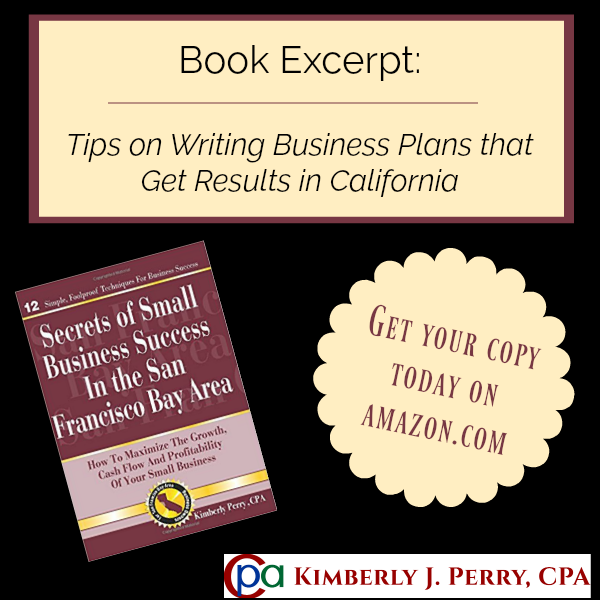Tips on Writing Business Plans that Get Results in California – March 13, 2018
 If you were traveling from New York to Alaska, and you had never been to Alaska, you would most likely consult a map for direction and guidance. If you didn’t, you could drive in circles for hours, if not days.
If you were traveling from New York to Alaska, and you had never been to Alaska, you would most likely consult a map for direction and guidance. If you didn’t, you could drive in circles for hours, if not days.
And if you didn’t ask anyone for directions, then you probably would not get there at all.
Unfortunately, many small-business owners attempt to do the same thing when they start their business. They start and continue to operate with no such map.
The end result is usually failure. With a business plan as your road map, your journey is not only much simpler, but your confidence is much higher.
A business plan is a written description of your business’ future. It’s a written document that explains and analyzes your business, and gives detailed projections about its future.
In short, it describes what you plan to do and how you plan to do it. A business plan covers all significant areas of the business including business strategy, marketing analysis, financial analysis and operations.
The Problem with Business Plans
The problem is that most business plans, once written, sit on a shelf and collect dust.
The first reason for that is that most business plans are written because the business owner thinks of it as an exercise that “must be done.” When the task at hand to prepare a business plan is approached in this way, it lacks the passion, energy and vibrancy that a good business plan should have.
The second problem is that most business plans are static. There is usually no room for change. Revisiting your plan, however, gives you the opportunity to step back, examine and organize your thinking about the business, and makes sure you’re charting a successful course for the future.
Writing a business plan is a lot of work. So why take the time to write one? Because good planning leads to good success. Almost without exception, business owners who write a plan are pleased they have one. Those without a plan wish they had written one.
Here are some of the specific and immediate benefits you will derive from writing a business plan.
- Helps You Obtain Money
- Improves Your Odds of Success
- Keeps You On Track
Outline of a Complete Business Plan
A business plan customarily has a number of major elements or sections. Each of these elements serves a particular purpose in the overall presentation of your plan.
There are three main parts to a business plan:
- The first is the business concept: Here you discuss your business “industry,” your business structure, and your products or services.
- The second is the marketplace section: Here you define and analyze the potential buyers of your product or service. You also describe and analyze your competitors.
- The final section is the financial section: This includes your financial reports, e.g., the profit and loss statement, balance sheet, cash flow projections, and ratio analysis.
These three parts further break down into several key components.
Executive Summary
This is arguably the most important single part of your document. It provides a high-level overview of the entire plan that emphasizes the factors that you believe will lead to success. In essence, it is the business plan in miniature.
Someone who has finished reading your executive summary should be able to say, “So, that’s what these people are about.”
Market Research/Analysis
This presents an analysis of the market conditions that the business faces, sets forth the marketing strategy that the business will follow, and provides a detailed schedule of marketing activities to support sales.
Market research looks at the total industry, however it is defined. Analyze the data for both the total market and your specific customers. Your target market represents your potential customers, who may be defined by age, sex, race, affluence, education, physical characteristics, location, etc.
Quantify your target market. Is it growing? By how much? What are the spending habits of your targeted customers? Who is your competition and how aggressive is it?
Operations, Management and Fulfillment
This is where you detail how operational and management issues will be resolved, including contingency planning. Operations incorporate the physical plant, its capacity and ability to grow, and your needs in terms of contract and equipment purchases (or leases).
How adaptable is the plant for updating its process? Is the industry rapidly changing and improving quality? What is the minimum you can manufacture (or sell) to avoid losing money? What salaries are necessary to operate the business?
Financial Projections
This is another extremely important section. Your projections (and historical financial information, if you have it) demonstrate how the business can be expected to do financially if the business plan’s assumptions are sound.
Appendix
This is the place to present supporting documents, statistical analysis, product marketing materials, resumes of key employees, etc.
Using Your Business Plan and Keeping It Current
The mark of a good plan is its “usability.” Words on a page mean nothing, unless you can put those words into actions. A good plan dictates action. It is a guide for operating your business, especially in its initial stages.
In Conclusion
Every business needs a plan, just as every destination needs a way to reach it. Business planning, although not flashy or necessarily exciting, is essential to the development and organization of a successful business. Without a plan, there is no way to reach your goal!
For more on this topic, please check out my book “Secrets of Small Business Success in the San Francisco Bay Area“.